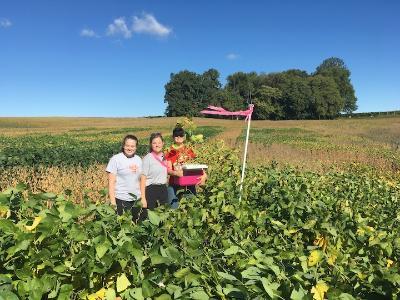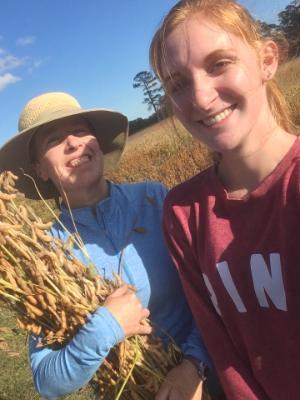VMI Biology Research Gets Published: Soybean Traits Studied

Three biology research students harvest soybean plants at a field farm in Orange, Virginia. —Photo courtesy of Col. Anne Alerding.
LEXINGTON, Va. Sept. 30, 2025 — A scholarly article addressing soybean research spanning seven years was published in the September 2025 issue of Agrosystems, Geosciences & Environment, a joint publication of American Society of Agronomy and Crop Science Society of America. The research was completed by Col. Anne Alerding, professor in the Department of Biology at Virginia Military Institute; alumni Angela Mullins ’19, Sarah Davis ’21, Rachael Dickenson ’22, Christopher Kushner ’24; Kristen Hoffman, a James Madison University alumna; and Dr. Aryeh Weiss, professor at Bar-Ilan University in Israel.
According to Alerding, who had wanted to begin a research project in her area of expertise, plant physiology, the idea of working with soybeans came after brainstorming with a former VMI colleague in the Department of Civil and Environmental Engineering. Together they obtained funds from the National Science Foundation to investigate using crop residues to make biofuels.
“I thought of soybean as the target crop because it would be a good plant to use in damaged growth regions in Virginia since they increase nitrogen in the soil. But the more I learned about soybeans, the more I realized I didn’t know enough about true farming with soybeans in commercial fields. I hadn’t considered the aspects and constraints of real farming, and I didn’t know how Virginia farmers selected and grew soybeans to maximize seed production.”
Alerding obtained grants from the Jeffress Memorial Trust and then the Virginia Soybean Board to fund her preliminary experiment, which began in earnest in 2017. She developed a relationship with an extension agent at Virginia Tech (VT), who helped her learn more about soybeans, and also helped her design a large-scale experiment on farm fields in Orange and in Tidewater.
Alerding learned that soybeans often dropped their seedpods during periods of drought, and wanted to solve the problem by learning how soybeans allocate resources within their bodies, selecting between growing new stems and leaves versus directing their energy to seedpods for reproduction. By identifying traits that promoted pod retention, she hoped to solve a practical agricultural problem by giving breeders and genetic engineers an idea of what traits to try to improve through breeding or gene manipulation.

With additional funding, Alerding was able to bring many students into the process of going back and forth to the fields to grow and harvest the plants, as well as analysis of the plants in the lab.
The final results for the paper were collected in May 2024.
Alerding reported that working on the project has been one of the most memorable and developmental parts of her career. “I experienced the best that our cadets have to offer as I witnessed their transformation from students into scientists in real time. I cannot imagine working at another college. There is no place that surpasses VMI in its financial and professional support for students and faculty in cultivating a world-class undergraduate research experience.”
Mullins, a cadet who worked on the project, is currently working on a doctorate in biomedical sciences at the University of North Dakota, where she is investigating the consequences of subclinical cow’s milk allergy. “We are interested in what happens to individuals who do not have severe or life-threatening reactions to milk, but instead have mild or delayed onset of symptoms, which may go un- or mis- diagnosed. Through my research at VMI, I gained valuable laboratory skills that I still use in my current research. I had opportunities to present my research as a cadet, which helped prepare me for presenting research at the graduate level,” she said.
Kushner, a current medical student at the Edward Via College of Osteopathic Medicine, said that the research that he conducted with Alerding was a rewarding opportunity. “During the interview process for medical school, many of the faculty appreciated the interdisciplinary aspect of my research. I can hands-down say it broadened my horizons and made me into a better scientist and researcher overall.”
Alerding is currently working with four additional cadets to finish data collection for the next publication.
Marianne Hause
Communications & Marketing
VIRGINIA MILITARY INSTITUTE
.svg)
.png)